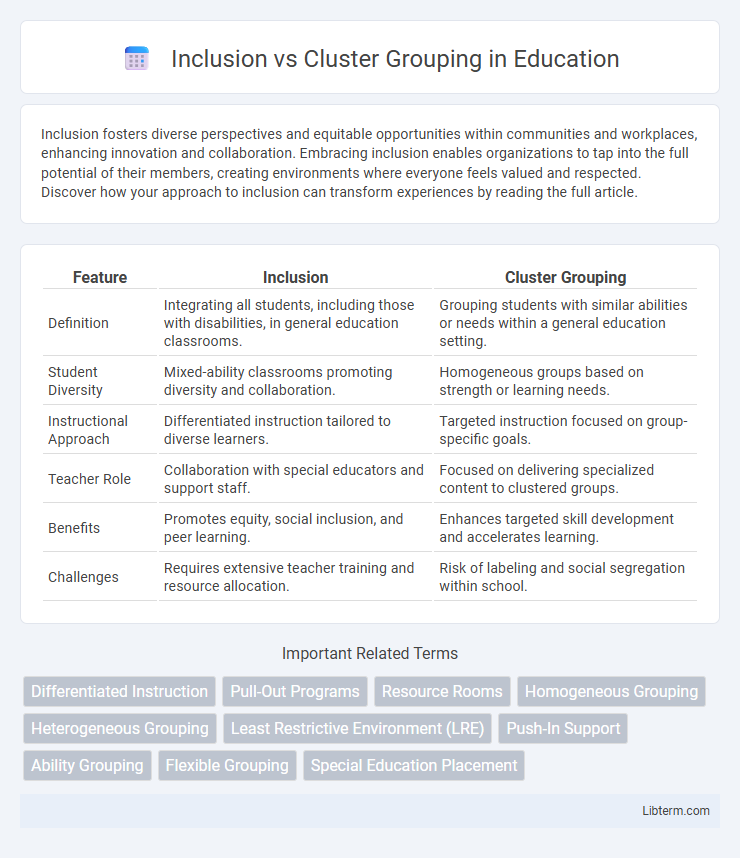Inclusion fosters diverse perspectives and equitable opportunities within communities and workplaces, enhancing innovation and collaboration. Embracing inclusion enables organizations to tap into the full potential of their members, creating environments where everyone feels valued and respected. Discover how your approach to inclusion can transform experiences by reading the full article.
Table of Comparison
| Feature | Inclusion | Cluster Grouping |
|---|---|---|
| Definition | Integrating all students, including those with disabilities, in general education classrooms. | Grouping students with similar abilities or needs within a general education setting. |
| Student Diversity | Mixed-ability classrooms promoting diversity and collaboration. | Homogeneous groups based on strength or learning needs. |
| Instructional Approach | Differentiated instruction tailored to diverse learners. | Targeted instruction focused on group-specific goals. |
| Teacher Role | Collaboration with special educators and support staff. | Focused on delivering specialized content to clustered groups. |
| Benefits | Promotes equity, social inclusion, and peer learning. | Enhances targeted skill development and accelerates learning. |
| Challenges | Requires extensive teacher training and resource allocation. | Risk of labeling and social segregation within school. |
Understanding Inclusion and Cluster Grouping
Inclusion integrates students with diverse learning needs into general education classrooms to promote equitable access and social interaction. Cluster grouping organizes students with similar abilities or needs into small groups within the same classroom to provide targeted instruction. Understanding these approaches helps educators tailor learning environments that balance individualized support and peer engagement.
Core Principles of Inclusive Education
Inclusion emphasizes integrating students with diverse learning needs into general education classrooms, promoting equity and personalized support to ensure all students participate meaningfully. Cluster grouping organizes students with similar abilities or needs into small groups within general education settings, facilitating targeted instruction while maintaining social integration. Core principles of inclusive education prioritize access, participation, and achievement for every learner by fostering collaboration among educators, adapting curriculum, and valuing diversity as a strength.
What is Cluster Grouping in Schools?
Cluster grouping in schools involves organizing students with similar abilities or interests into small, homogeneous groups within a heterogeneous classroom. This strategy allows teachers to tailor instruction to the group's skill level, promoting more effective learning and engagement. Unlike full inclusion, which places all students in mixed-ability settings, cluster grouping provides targeted enrichment while maintaining access to the general education environment.
Key Benefits of Inclusion
Inclusion promotes diverse classroom environments where students with special needs learn alongside their peers, fostering social integration and collaboration. It enhances individualized support within general education settings, improving academic outcomes and self-esteem for all students. Inclusive education also encourages empathy and acceptance, preparing students for diverse real-world interactions.
Advantages of Cluster Grouping
Cluster grouping enhances academic achievement by grouping students with similar abilities, allowing for targeted instruction tailored to their specific learning needs. This structured environment fosters peer collaboration and challenges students through enriched curricula, promoting deeper understanding and motivation. Teachers in cluster groups can more efficiently plan lessons and interventions, resulting in improved student engagement and progress.
Challenges of Inclusive Classrooms
Inclusive classrooms present challenges such as diverse learning needs, requiring teachers to differentiate instruction effectively while managing limited resources and time constraints. Behavioral issues and social integration difficulties may arise, making it essential to balance academic support with fostering a positive classroom environment. Ensuring adequate professional development and collaboration among educators is crucial for addressing these complexities and meeting the needs of all students.
Potential Drawbacks of Cluster Grouping
Cluster grouping can lead to increased segregation and limit diverse social interactions among students, potentially reinforcing achievement gaps. This approach may reduce opportunities for equitable access to varied instructional methods and peer learning found in inclusive settings. Over-reliance on cluster grouping risks stigmatizing students placed in lower-performing clusters, impacting their motivation and self-esteem.
Comparing Academic Outcomes: Inclusion vs Cluster Grouping
Inclusion classrooms integrate students with diverse abilities, promoting social interaction and individualized support, often resulting in improved academic outcomes for students with mild to moderate disabilities compared to segregated settings. Cluster grouping places students with similar abilities together within a general education environment, allowing for targeted instruction and accelerated learning, which can enhance achievement for gifted learners. Research indicates inclusion benefits peer modeling and social skills development, while cluster grouping optimizes academic challenge and pacing, highlighting distinct advantages depending on student needs.
Social-Emotional Impact on Students
Inclusion fosters diverse social interactions, enhancing empathy, cooperation, and emotional resilience among students by integrating them into general education settings. Cluster grouping can create a sense of belonging and support within a smaller peer group but may limit exposure to diverse perspectives and social experiences. Research indicates that inclusive environments more effectively promote social-emotional development through increased peer modeling and collaborative learning opportunities.
Choosing the Right Approach for Diverse Learners
Choosing between inclusion and cluster grouping depends on the specific needs of diverse learners and the resources available within a school. Inclusion integrates all students in general education classrooms with tailored support, benefiting social interaction and access to the standard curriculum, while cluster grouping arranges students with similar abilities or needs together, enhancing targeted instruction and peer collaboration. Educators must analyze factors such as student learning profiles, support services, and academic goals to select the most effective strategy that promotes equitable learning outcomes.
Inclusion Infographic

 libterm.com
libterm.com